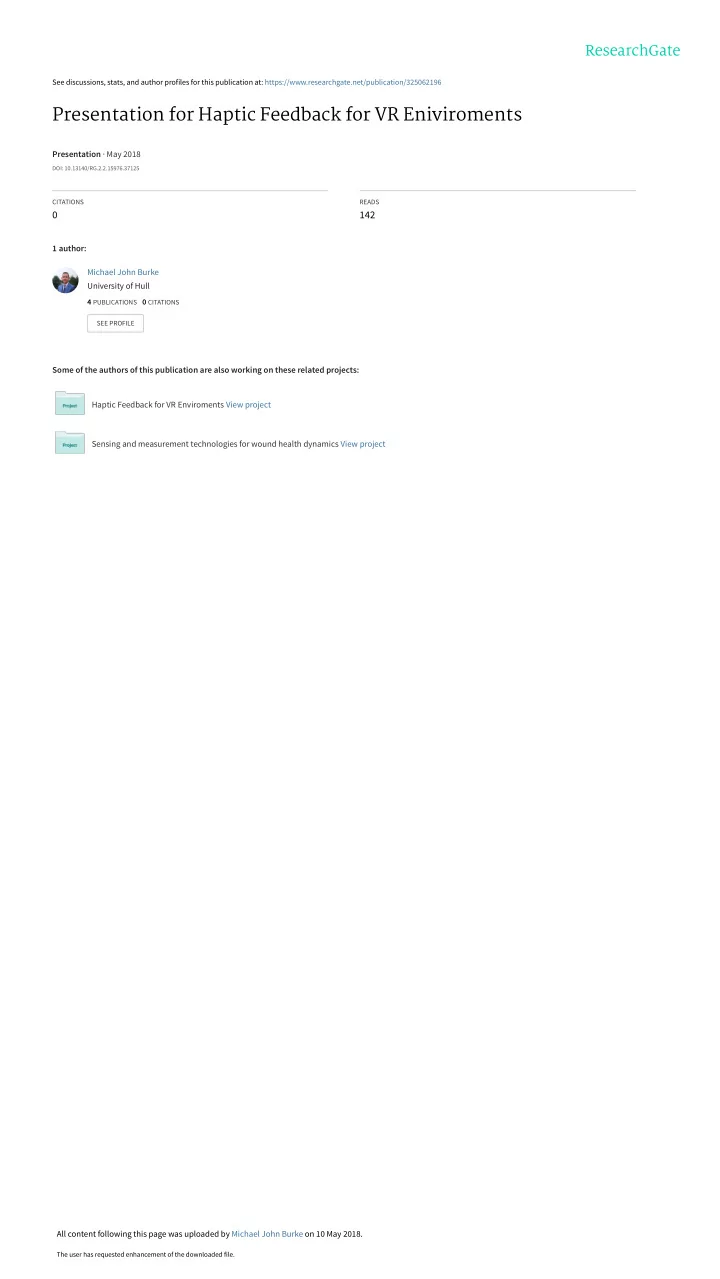

See discussions, stats, and author profiles for this publication at: https://www.researchgate.net/publication/325062196 Presentation for Haptic Feedback for VR Eniviroments Presentation · May 2018 DOI: 10.13140/RG.2.2.15976.37125 CITATIONS READS 0 142 1 author: Michael John Burke University of Hull 4 PUBLICATIONS 0 CITATIONS SEE PROFILE Some of the authors of this publication are also working on these related projects: Haptic Feedback for VR Enviroments View project Sensing and measurement technologies for wound health dynamics View project All content following this page was uploaded by Michael John Burke on 10 May 2018. The user has requested enhancement of the downloaded file.
Haptic Feedback for VR Environments S tudent - Michael Burke 201403540 1st S upervisor – Dr. Anthony Bateson 2nd S upervisor – Dr. Jon Purdy
Introduction • The aim for this proj ect was to create a “ haptic feedback device in a wearable, scalable manner” (Lindeman, 2003), in the form of a j acket that uses solenoids as a feedback medium, for use in virtual reality (VR) environments. The system described could potentially be used as “ a valuable training aid where training in real life situations would be impractical because, for example, it would be dangerous, logistically difficult, unduly expensive” (Rose, 2000).
Inspiration • The inspiration for this proj ect was to increase user engagement in virtual reality worlds through the use of haptic feedback. Inspiration for Haptic Jacket (www. blog.cloudhelix.io)
Background • A good haptic feedback system would provide valuable stimulus to the user, which should allow the user to feel more immersed in their chosen environment. • VR systems have become more immersive with technology, such as the Oculus Rift which is said to “ provide the user with experiences that were earlier thought to be merely a dream or nightmare.” (Dasai, 2014).
Existing Products 3rd S pace Jacket (3rd S UBP AC M2 Jacket KOR-FX 4DFX Jacket S pace Jacket, 2017) (S ubPac M2, 2017) (KOR-FX, 2017) WOOJER Jacket HARDLIGHT VR Jacket (Wooj er Vest, 2017) (Hardlight VR,2017)
Concepts • Compressed air concept was discarded quickly since the idea of carrying an air compressor was large, impractical, expensive and noisy. • transducers; however, it was 12V Air Compressor (www.quadratec.com) discarded because of cost, size and safety matters. The transducers can also cause artifacts in medical devices. Micro Transducers used in a P300 study (H Y aj ima, 2014).
Aims & Objectives • Creating software for the Arduino µController • Creating a first person shooter (FPS ) virtual environment (VE) in Unity3D • Building hardware for Haptic Jacket • Testing VE and Hardware • Testing with human participant s to show levels of engagement (Ethics)
Flow Chart 2 nd S tage PLAYER YES ARDUINO S TART CARR Y’ S RECIEVES DATA ON NO MARKS ERP DATA WITH EEG NO ARDUINO S ENDS GAME CARR Y FINIS H CONTROL S IGNAL ON COLIS ION OUTPUT TO PC YES GAME S ENDS DATA ACTIV ATES VIA US B S OLENOIDS
Progress • Developed a fully working VE using Unity 3D. • Designed the Electronics for the j acket. • Designed a printed circuit board using EAGLE. • Built a Haptic Feedback Jacket. • Tested the Haptic j acket with the developed VE
Results & Testing • Virtual Environment • VE Level Map • Teleportation (Lack of movable area) • Hit Event Player • Hit Event Enemy • Gun Firing S ound FX • Final Obj ective (Defuse the Bomb)
Results & Testing • Virtual Environment Map • S tart (Green) • Enemy Location (Orange) • Final Obj ective (Red)
Results & Testing • Teleportation S ystem • HTC Hardware • Teleportation Reticule (Red)
Results & Testing • Hit Event • Raycast (Green Line) • Player Transform (Green Box) • Player Hit Event
Results & Testing • Final Obj ective • Defuse Bomb • Plays Pickup S ound FX
Results & Testing
Results & Testing • Haptic Feedback Jacket • Hardware Built & Tested inc. PCB, Arduino, Power • Jacket Constructed • Player Hit Event Registered • Data Output via COM port (Hit Event) • µController Activates S olenoid
Results & Testing • Hardware Built & Tested • PCB • Power Boost • Integrating Arduino MEGA
Results & Testing • Construction of Haptic Jacket • Ingrating S olenoids with µController. • Creating Zones S olenoids • Constructing Final Jacket
Results & Testing
Project Management
Project Management
Conclusion • The main focus of the proj ect was to make the VE more immersive to participants. • To measure of how immersive the environment is with and without haptic feedback. • The VE and j acket were fully built and tested together. • Human participant trail would have possibly shown more conclusive data.
Future Work • Improving Vest Feedback Zones • Larger Test Group (Ethics) • Design more Haptic Technology such as Arms, Gloves and Legs Future of VR, (www.conceptsvideo.com, 2018)
Problems • Originally a commercial game was going to be reverse engineered. • Human participant testing was going to take place, ethics were applied for.
References • Lindeman. W, R.W. and Cutler., 2003, Controller Design for a Wearable, Near-Field Haptic Display, Proc. of the 11th S ymp. on Haptic Interfaces for Virtual Environment and Teleoperator S ystems, pp.1. • Rose, F .D., Attree, E.A., Brooks, B.M., Parslow, D.M. and Penn, P .R., 2000. Training in virtual environments: transfer to real world tasks and equivalence to real task training. Ergonomics , 43 (4), pp.494-511. • Y aj ima, H., Makino, S . and Rutkowski, T .M., 2014, December. P300 responses classification improvement in tactile BCI with touch-sense glove. In S ignal and Information Processing Association Annual S ummit and Conference (APS IP A), 2014 Asia-Pacific (pp. 1-7). IEEE.
Questions View publication stats View publication stats
Recommend
More recommend